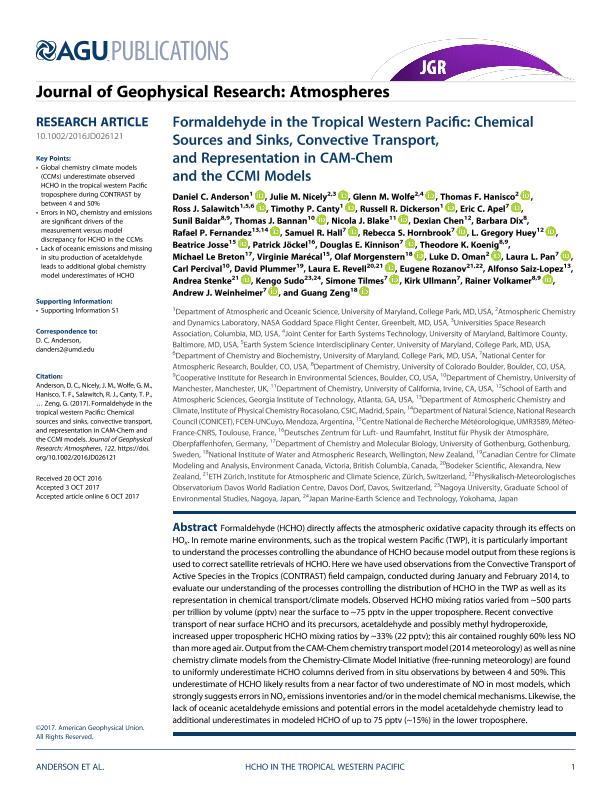Artículo
Formaldehyde in the tropical western pacific: Chemical sources and sinks, convective transport, and representation in CAM-Chem and the CCMI models
Anderson, Daniel C.; Nicely, Julie M.; Wolfe, Glenn M.; Hanisco, Thomas F.; Salawitch, Ross J.; Canty, Timothy P.; Dickerson, Russell R.; Apel, Eric C.; Baidar, Sunil; Bannan, Thomas J.; Blake, Nicola J.; Chen, Dexian; Dix, Barbara; Fernandez, Rafael Pedro ; Hall, Samuel R.; Hornbrook, Rebecca S.; Huey, L. Gregory; Josse, Beatrice; Jöckel, Patrick; Kinnison, Douglas E.; Koenig, Theodore K.; Le Breton, Michael; Marécal, Virginie; Morgenstern, Olaf; Oman, Luke D.; Pan, Laura L.; Percival, Carl; Plummer, David; Revell, Laura E.; Rozanov, Eugene; Saiz-lopez, Alfonso; Stenke, Andrea; Sudo, Kengo; Tilmes, Simone; Ullmann, Kirk; Volkamer, Rainer; Weinheimer, Andrew J.; Zeng, Guang
; Hall, Samuel R.; Hornbrook, Rebecca S.; Huey, L. Gregory; Josse, Beatrice; Jöckel, Patrick; Kinnison, Douglas E.; Koenig, Theodore K.; Le Breton, Michael; Marécal, Virginie; Morgenstern, Olaf; Oman, Luke D.; Pan, Laura L.; Percival, Carl; Plummer, David; Revell, Laura E.; Rozanov, Eugene; Saiz-lopez, Alfonso; Stenke, Andrea; Sudo, Kengo; Tilmes, Simone; Ullmann, Kirk; Volkamer, Rainer; Weinheimer, Andrew J.; Zeng, Guang
 ; Hall, Samuel R.; Hornbrook, Rebecca S.; Huey, L. Gregory; Josse, Beatrice; Jöckel, Patrick; Kinnison, Douglas E.; Koenig, Theodore K.; Le Breton, Michael; Marécal, Virginie; Morgenstern, Olaf; Oman, Luke D.; Pan, Laura L.; Percival, Carl; Plummer, David; Revell, Laura E.; Rozanov, Eugene; Saiz-lopez, Alfonso; Stenke, Andrea; Sudo, Kengo; Tilmes, Simone; Ullmann, Kirk; Volkamer, Rainer; Weinheimer, Andrew J.; Zeng, Guang
; Hall, Samuel R.; Hornbrook, Rebecca S.; Huey, L. Gregory; Josse, Beatrice; Jöckel, Patrick; Kinnison, Douglas E.; Koenig, Theodore K.; Le Breton, Michael; Marécal, Virginie; Morgenstern, Olaf; Oman, Luke D.; Pan, Laura L.; Percival, Carl; Plummer, David; Revell, Laura E.; Rozanov, Eugene; Saiz-lopez, Alfonso; Stenke, Andrea; Sudo, Kengo; Tilmes, Simone; Ullmann, Kirk; Volkamer, Rainer; Weinheimer, Andrew J.; Zeng, Guang
Fecha de publicación:
10/2017
Editorial:
American Geophysical Union
Revista:
Journal of Geophysical Research: Atmospheres
ISSN:
2169-8996
Idioma:
Inglés
Tipo de recurso:
Artículo publicado
Clasificación temática:
Resumen
Formaldehyde (HCHO) directly affects the atmospheric oxidative capacity through its effects onHOx. In remote marine environments, such as the tropical western Pacific (TWP), it is particularly importantto understand the processes controlling the abundance of HCHO because model output from these regions isused to correct satellite retrievals of HCHO. Here we have used observations from the Convective Transport ofActive Species in the Tropics (CONTRAST)field campaign, conducted during January and February 2014, toevaluate our understanding of the processes controlling the distribution of HCHO in the TWP as well as itsrepresentation in chemical transport/climate models. Observed HCHO mixing ratios varied from ~500 partsper trillion by volume (pptv) near the surface to ~75 pptv in the upper troposphere. Recent convectivetransport of near surface HCHO and its precursors, acetaldehyde and possibly methyl hydroperoxide,increased upper tropospheric HCHO mixing ratios by ~33% (22 pptv); this air contained roughly 60% less NOthan more aged air.Output from the CAM-Chem chemistry transport model (2014 meteorology)as well asninechemistry climate models from the Chemistry-Climate Model Initiative (free-running meteorology) are foundto uniformly underestimate HCHO columns derived from in situ observations by between 4 and 50%. Thisunderestimate of HCHO likely results from a near factor of two underestimate of NO in most models, whichstrongly suggests errors in NOxemissions inventories and/or in the model chemical mechanisms. Likewise, thelack of oceanic acetaldehyde emissions and potential errors in the model acetaldehyde chemistry lead toadditional underestimates in modeled HCHO of up to 75 pptv (~15%) in the lower troposphere.
Palabras clave:
Formaldehide
,
Oxidative Capacity Of the Atmosphere
,
Contrast
,
Cam-Chem
,
Ccmi
Archivos asociados
Licencia
Identificadores
Colecciones
Articulos(CCT - MENDOZA)
Articulos de CTRO.CIENTIFICO TECNOL.CONICET - MENDOZA
Articulos de CTRO.CIENTIFICO TECNOL.CONICET - MENDOZA
Citación
Anderson, Daniel C.; Nicely, Julie M.; Wolfe, Glenn M.; Hanisco, Thomas F.; Salawitch, Ross J.; et al.; Formaldehyde in the tropical western pacific: Chemical sources and sinks, convective transport, and representation in CAM-Chem and the CCMI models; American Geophysical Union; Journal of Geophysical Research: Atmospheres; 122; 20; 10-2017; 11201-11226
Compartir
Altmétricas



